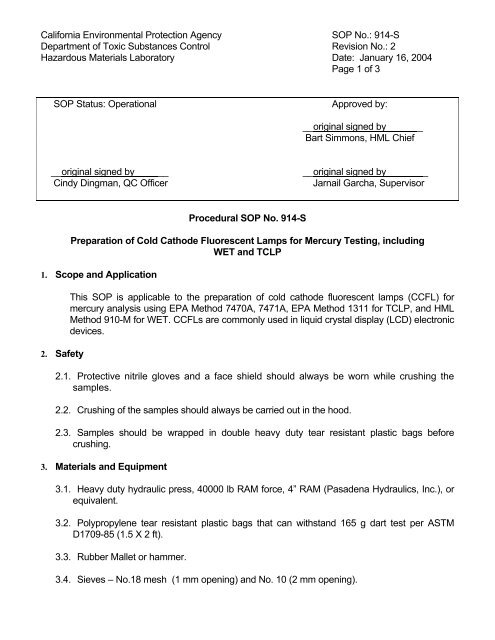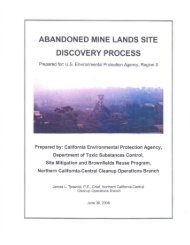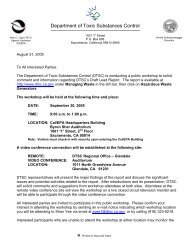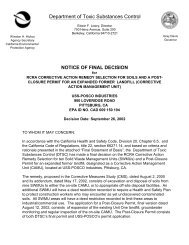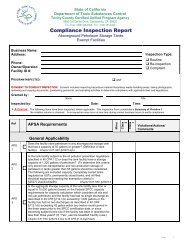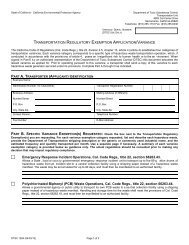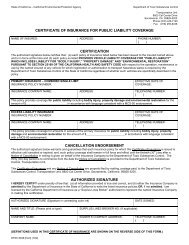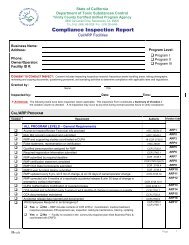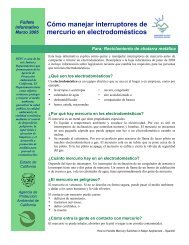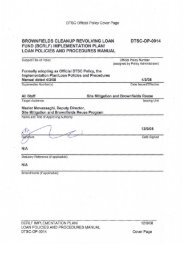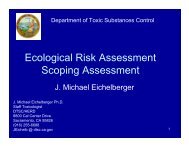California Environmental Protection Agency SOP No.: 914-S ...
California Environmental Protection Agency SOP No.: 914-S ...
California Environmental Protection Agency SOP No.: 914-S ...
Create successful ePaper yourself
Turn your PDF publications into a flip-book with our unique Google optimized e-Paper software.
<strong>California</strong> <strong>Environmental</strong> <strong>Protection</strong> <strong>Agency</strong> <strong>SOP</strong> <strong>No</strong>.: <strong>914</strong>-S<br />
Department of Toxic Substances Control Revision <strong>No</strong>.: 2<br />
Hazardous Materials Laboratory Date: January 16, 2004<br />
Page 1 of 3<br />
<strong>SOP</strong> Status: Operational Approved by:<br />
__original signed by_______<br />
Bart Simmons, HML Chief<br />
__original signed by ______ __original signed by________<br />
Cindy Dingman, QC Officer Jarnail Garcha, Supervisor<br />
Procedural <strong>SOP</strong> <strong>No</strong>. <strong>914</strong>-S<br />
Preparation of Cold Cathode Fluorescent Lamps for Mercury Testing, including<br />
WET and TCLP<br />
1. Scope and Application<br />
2. Safety<br />
This <strong>SOP</strong> is applicable to the preparation of cold cathode fluorescent lamps (CCFL) for<br />
mercury analysis using EPA Method 7470A, 7471A, EPA Method 1311 for TCLP, and HML<br />
Method 910-M for WET. CCFLs are commonly used in liquid crystal display (LCD) electronic<br />
devices.<br />
2.1. Protective nitrile gloves and a face shield should always be worn while crushing the<br />
samples.<br />
2.2. Crushing of the samples should always be carried out in the hood.<br />
2.3. Samples should be wrapped in double heavy duty tear resistant plastic bags before<br />
crushing.<br />
3. Materials and Equipment<br />
3.1. Heavy duty hydraulic press, 40000 lb RAM force, 4” RAM (Pasadena Hydraulics, Inc.), or<br />
equivalent.<br />
3.2. Polypropylene tear resistant plastic bags that can withstand 165 g dart test per ASTM<br />
D1709-85 (1.5 X 2 ft).<br />
3.3. Rubber Mallet or hammer.<br />
3.4. Sieves – <strong>No</strong>.18 mesh (1 mm opening) and <strong>No</strong>. 10 (2 mm opening).
<strong>California</strong> <strong>Environmental</strong> <strong>Protection</strong> <strong>Agency</strong> <strong>SOP</strong> <strong>No</strong>.: <strong>914</strong>-S<br />
Department of Toxic Substances Control Revision <strong>No</strong>.: 2<br />
Hazardous Materials Laboratory Date: January 16, 2004<br />
Page 2 of 3<br />
3.5. Glass containers.<br />
3.6. Freezer (-12 0 C).<br />
3.7. Scissors or Wire cutter.<br />
3.8. Mortar and Pestle.<br />
4. Procedure:<br />
4.1. For Total Mercury , TCLP and WET Determinations<br />
4.1.1. Cut the end cap wiring attached to the lamp with the scissors or a wire cutter. Record<br />
the weight and store separately or save the wiring with the metal fraction of the<br />
device, if appropriate, as described in HML <strong>SOP</strong> 916-S. Store samples at minus 12 0<br />
C.<br />
4.1.2. Weigh and record the weight of each lamp (or all lamps for a composite sample, if<br />
TCLP and or WET analysis is required) along with the end caps.<br />
4.1.3. Place the lamp with the end caps intact into a double heavy duty polypropylene<br />
plastic bag. For longer lamps use extra long bags. Leave the sample containing bag<br />
in a freezer for one hour.<br />
<strong>No</strong>te: Do not remove the end caps or break the sample before freezing.<br />
4.1.4. Take the frozen sample (in the plastic bag) out of the freezer and break the lamp<br />
initially with a rubber mallet or a hammer into small pieces, then crush the lamp under<br />
the hydraulic press (if necessary).<br />
4.1.5. Transfer the crushed samples from the plastic bag into a mortar and grind with the<br />
pestle until all the materials pass through the 1mm sieve for total Hg analysis, and<br />
use the 2mm sieve for WET & TCLP. Weigh and set aside the visible small end cap<br />
copper wire pieces.<br />
4.1.6 Weigh and transfer the sieved sample into a glass container and store at -12 0 C.<br />
4.1.7. Take an aliquot of 0.2 to 1.0 gram of the above prepared sample for total Hg analysis<br />
by EPA Method 7471A (or use the entire sample if necessary, to meet the detection<br />
limit criteria for this analysis). Test sub-samples in triplicate.
<strong>California</strong> <strong>Environmental</strong> <strong>Protection</strong> <strong>Agency</strong> <strong>SOP</strong> <strong>No</strong>.: <strong>914</strong>-S<br />
Department of Toxic Substances Control Revision <strong>No</strong>.: 2<br />
Hazardous Materials Laboratory Date: January 16, 2004<br />
Page 3 of 3<br />
4.1.8. If enough sample material is available, take an aliquot of the sample from step 4.1.6<br />
of the above procedure for WET and TCLP analysis.<br />
4.1.9. Five to ten grams of sample may be used for WET and /or TCLP, based on sample<br />
availability. Add a proportionate amount of extracting fluids to the sample and perform<br />
WET and/or TCLP extractions as outlined in HML Method 910-S and EPA Method<br />
1311, respectively, and determine Hg concentrations by EPA Method 7470A.<br />
5. References<br />
Important <strong>No</strong>te: For WET and TCLP, use extraction vessels that can<br />
accommodate the sample and the extraction fluid with as little head space as<br />
possible to avoid any loss of Hg due to dissipation or evaporation.<br />
Digest the extracts right after the extraction. Mercury may dissipate or<br />
evaporate in the head space if the extracts are stored for an extended period of<br />
time.<br />
5.1. <strong>California</strong> Code of Regulations, Title 22, Vol. 29, Article 11, Sections 66699, 66700.<br />
5.2. Toxicity Characteristic Leaching Procedure, Federal Register, Method 1311, SW-846.<br />
5.3. Test Methods for Evaluating Wastes: Physical/Chemical Methods, US <strong>Environmental</strong><br />
<strong>Protection</strong> <strong>Agency</strong>, Office of Solid Waste Washington, DC, SW846, Vol. 1A, 3rd Edition,<br />
Update III.<br />
6. Acknowledgement<br />
This procedure was developed by the Inorganic Section of the Hazardous Materials<br />
Laboratory, Department of Toxic Substances. For more information please contact Jarnail<br />
Garcha at (510) 540-3468.


